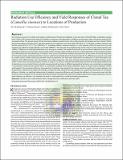| dc.description.abstract | Tea in Kenya is grown in the high and medium rainfall areas of the Kenyan highlands in east and west of the Rift Valley, at altitudes ranging from 1300 to 2700 m above mean sea level. Variability in responses of tea genotypes to different environments affects the growth, productivity, and quality of tea. The annual receipt of total shortwave radiation received at any site is determined by the latitude and local climate. Within tea growing regions of Eastern Africa, the main receipt of solar radiation varies from 6500–6700 (MJm -2 y -1) at Mufindi, southern Tanzania and Kericho, Kenya, (00. 22’S 35.0 21’E) to 7400 MJm-2 y-1 at Mulanje, Malawi. Seasonal variations in solar radiation within the year also occur and incident solar radiation at high altitudes can exceed 1000Wm-2 . However, the net available energy at the surface of a tea canopy reaches only 100Wm -2 . Differences in total light penetration occur among tea varieties. The weight of tea shoots in any one harvest depends on the number developing shoot per unit area, their rate of growth and the average weight of shoots at harvest. Yield components of tea are determined by dry matter production and partitioning. The yield of a tea crop is not primarily limited by the production of dry matter, but by the proportion of the total dry matter partitioned into the “economic yield” of harvestable shoots the harvest index (HI; %). Differences in ground cover, total dry matter and dry matter partitioning between clones and between sites have been attributed to the differences in daily intercepted solar radiation which differ between sites. Nevertheless, dry matter production rates have not been determined for the different Kenyan grown clones in the various tea growing regions of Kenya. A study on 12 clones to evaluate the relationships between the intercepted radiation and its derivatives, environmental factors and yields among selected tea clones in different geographical locations, was conducted on a genotype × environment comprising 20 cultivars laid in a randomized complete block design replicated 3 times, at three locations (Kipkebe, Timbili and Kangaita). The conversion efficiency, the proportion of radiation intercepted by the canopy, extinction coefficient, incident radiation, and temperature, combined were highly and strongly correlated to yield. However, the only altitude was a significant determinant of conversion efficiency. Altitude is a significant determinant of radiation conversion efficiency and through the efficiency of conversion varies with the location it only contributes to the overall locational parameters that determine yield, the strongest determinant being temperature. Harvest index radiation use efficiency can, therefore, be used as a yield predictor in clonal tea breeding programmes. | en_US |

